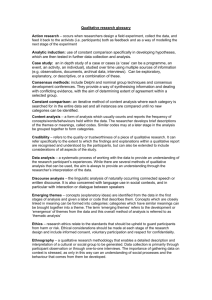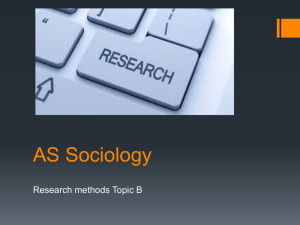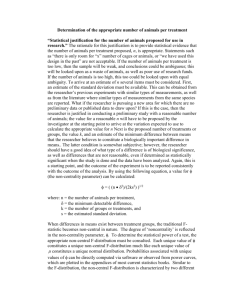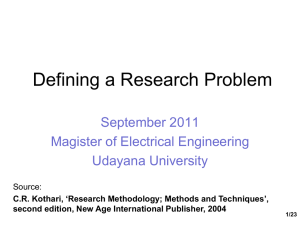Observational Studies
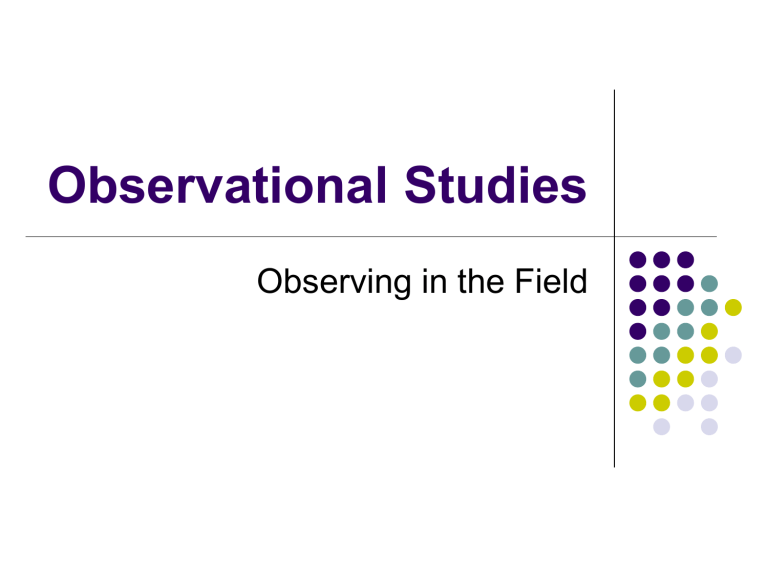
Observational Studies
Observing in the Field
Two types of observation
Nonparticipant observation. Researcher is not part of the activity taking place, but simply observes. May be identified as observer/research.
Participant observer. Researcher takes part in community, organization, or activity.
Researcher attempts to learn what it is like to be part of the community, organization, or participate in the activity.
In both types of observation, the researcher attempts to learn about context in which behavior takes place. Context includes:
Physical surroundings.
Other people in the setting.
The interactions among different people in the setting.
The social, cultural, political, or economic context in which the behavior occurs and why it occurs.
Why do we observe:
To add to our understanding of interview data.
To identify patterns that may occur in the behavior of people, social interactions, or the setting.
To see patterns people are unwilling to talk about.
To provide direct personal experience and knowledge.
To add to or “move beyond” the perception of both the researcher and participants.
In addition to observation, researcher may:
Interview participants.
Interview key informants or people “in the know” about the setting, surroundings, or context.
In social work practice settings, key informants may be called “community guides,” helping the social worker learn about and gain access to a community.
If someone wanted to learn about your community, what would you tell them to do?
What would you tell them about community customs and behaviors?
What types of things do we observe:
Formal and informal patterns of interaction among people.
Ways people organize themselves
Informal or formal rules in operation
Recurring events
“Down time” when things don’t happen
Sequence of events
Differences in what happens at various times
Ritual and Ceremonies
Crises
Unplanned activities.
Styles of Observation
Unstructured observation – describing what occurs.
Researcher usually does not have a preconceived idea about what would occur.
Semi-Structured observation [using a checklist to record what you have found]. Requires that you have an idea about what will be found.
Structured observation. Starting with an operational definition of what you want to measure – and counting only the behavior or situation that “fits” the definition.
Researchers record what they see, hear, smell, and taste using:
Field notes. Written record of what is observed, impressions, reactions, and hypotheses about what has happened.
Photos of people and setting may be added to analysis.
Audio-tape and video-tape are also used to document what researchers find.
How to record field notes:
Record what one observes during observation.
Expand on notes after the observation.
Complete your sentences – add description.
Write a narrative [several paragraphs] that describes what you saw in detail. Narratives are also called “thick description” and in most qualitative research also include information on researcher reactions and interpretation.
Other things you can use to help with observation:
Tables
Checklists
Diagrams and maps
Content Analysis:
We also can add to interviews or observation by conducting content analysis on things produced “in the course of everyday events” (Rossman & Rollis, p. 197). This is also referred to in our text as studying material culture.
Social workers often analyze case records, organization documents, intake records, letters etc.
Videos, newspapers, books, movies, etc. can also be analyzed for content.
The researcher looks for reoccurring patterns in the documents.
Example of Observation that includes Document
(Website Analysis) http://www.vimeo.com/986157
Question: Did the researcher find patterns in the data?
Did the patterns allow her to form a hypotheses about differences in websites preferred by athletes vs. non-athletes?
What to include in field notes:
Where you observe
Who was there or not there
What happened
What events happened
What events took place
Provide details:
Use descriptive adjectives
Use action verbs
Avoid making judgments about what you see
Be as specific as you can!
Research paradigm note:
The Participant Observation article that you were assigned to read suggests that observations should be objective [just the facts] rather than subjective
[interpretation by the researcher].
This is different from what we talked about in terms of observation using the qualitative approach as described by Rossman & Rollis. Qualitative methods are interpretative, using appropriate controls to limit researcher bias and make sure the researcher’s interpretation accurately reflects the experiences or opinions of the people studied!
From
Qualitative Research Methods: A Data Collector’s Field Guide published by Family Health International, What to observe, p. 20
Category
Appearance
Includes
Clothing, age, gender physical appearance.
Researcher should note
Anything that might indicate membership in groups or in sub-populations of interest to the study, such as profession, social status, socioeconomic class, religion, or ethnicity
Verbal Behavior and
Interactions
Physical behavior and gestures
Personal space
Human traffic
People who stand out
Who speaks to whom and for how long; who initiates interaction; language, dialect spoken, tone of voice.
What people do, who does what, who interacts with whom, who is not interacting
Gender, age, ethnicity, and profession of speakers; dynamics of interaction
How people use their bodies and voices to communicate different emotions; what individuals’ behaviors indicate about their feelings toward one another, their social rank, or their profession
What individuals’ preferences concerning personal space suggest about their relationships
How close people stand to one another
People who enter, leave, and spend time at the observation site
Identification of people who receive a lot of attention from others
Where people enter and exit; how long they stay; who they are (ethnicity, age, gender); whether they are alone or accompanied; number of people
The characteristics of these individuals; what differentiates them from others; whether people consult them or they approach other people; whether they seem to be strangers or well known by others present
Social Work Practice
Applications:
Use observation and content analysis to learn about client and his/her environment (family, school, culture).
Learn about community and organization systems.
Conduct assessments.
Develop interventions
Use evaluations of interventions and programs.
Out of Class Exercise – we will discuss next Thursday.
Watch at least 30 minutes of TV. During that time, try to observe each of the commercials. Look for instances of racism or sexism in the commercials.
Choose either qualitative or quantitative approaches.
1) Qualitative – take notes. Try to determine if you see a pattern in the contents of commercials (types of products; how people are depicted, etc).
2) Quantitative. Create an operational definition of racist or sexist behavior you might expect to see in commercials. Count the number of times the behavior occurs.



